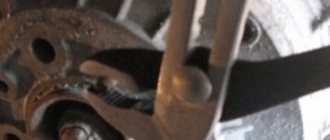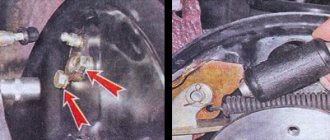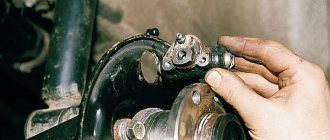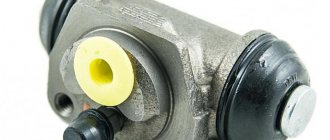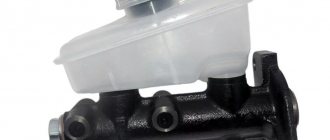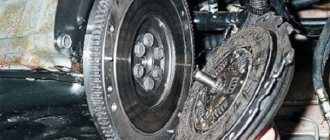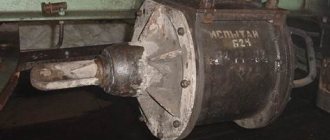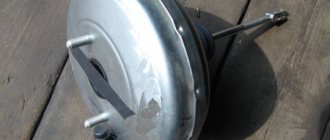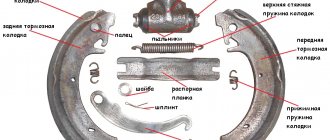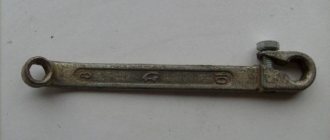After using the Priora for a long time, a number of problems may appear with the braking system, especially the front wheels:
- caliper rattling
- guide bracket jamming
- Uneven wear of the front brake pads
Very often, the reason for all this can be wear on the caliper pins, which results in excessive play of the bracket in the caliper, which leads to the problems mentioned above. To avoid this, it is necessary to monitor the condition of the caliper boots and, if any tears or other damage is detected, replace them immediately.
To carry out such an inspection of the Priora brake system, we will need the following accessories:
- Open-end wrenches for 13 and 17 mm
- Flat blade screwdriver
- Caliper Lubricant
- Brake cleaner
Replacing caliper guide pins and anthers on a Priora
First of all, we lift the front part of the car, after which we unscrew the bolts securing the wheel, then remove it. Next, using a 13 and 17 mm wrench, unscrew the bolts securing the caliper to the bracket, as shown in the photo below. Of course, you must first bend the locking washers using a flat-head screwdriver.
We do the same with the second bolt from the bottom. Then use a screwdriver to press the piston of the brake cylinder until the caliper opens without any problems.
The result of which is shown below.
Now you can start removing the fingers and the anthers themselves, as shown in the picture.
If the wear on your fingers is small, you don’t have to replace them. But cleaning and removing plaque is a mandatory procedure. It is also worth cleaning the pin hole in the caliper bracket.
Then we take a special grease for calipers, lubricate the pin and put on a new boot.
If excess grease gets on the active brake parts, remove it with a cleaner. We install the pins in place and assemble the caliper in the reverse order.
The pin assembly with boot on a Priora costs about 40 rubles, but if you need to buy just boots, then for 40 rubles you can buy a complete set for both calipers. It is especially worth noting that for fingers it is necessary to use a special lubricant that will work at high temperatures.
How much does a caliper cost on a Priora: standard part - article number and price
When buying a front braking element for a Priora, you have the option of buying it assembled or “naked” - without a special bracket.
- Right (assembled). Catalog number 11180-3501012-20. Price – 3600 rubles.
- Right (naked). Catalog number 11180-3501014-00. Price – 2,400 rubles.
- Left (assembled). Catalog number 11180-3501013-50. Price – 3,850 rub.
- Left (naked). Catalog number 11180-3501015-00. Price – 2,400 rubles.
The Priora caliper repair kit is available in two versions:
- Riginal RG2108-3501410 – 800 RUR;
- VAZ-2108 BRT 23R – 150 rub.
Which rear pads to choose for Lada Priora
Before deciding on the brand of pads, you need to know for sure whether your car has an ABS system or not. The pads for Priora with and without abs are different.
Rear brake pads for Priora with ABS
- Pilenga BSP1005N with ABS price from 600 rub.
- AT AT2090-118BP (chekhtya) price from 400 rub.
- AUTOREAL AV18-3502090 price from 400 rub.
Rear pads for Priora without ABS
- Pilenga BST1002N price from 500 rub.
- Start 2108-3502090 price from 400 rub.
- Bosch 0986487219 price from 800 rub.
- Fortech FB-2102 price from 500 rub.
Determining the presence of an ABS sensor is not difficult. It is also located on the brake shield. You can see what the sensor looks like in the photo.
The brake system of the Lada Priora with ABS is slightly different from the model without a sensor. Design differences can be seen in the photo.
Basic caliper malfunctions
Just like with a human illness, you need to be extremely careful with the running of your car, paying due attention to the signs of illness that appear. As for the braking system, malfunctions in it can manifest themselves in the following form:
- the brakes work sluggishly, you literally have to press the pedal to stop;
- when braking, the car wobbles or pulls to the right or left;
- weak shocks and vibration are heard in the brake pedal;
- the pedal became heavier;
- The braking element is jammed - it does not move away from the brake disc.
HOW TO CHOOSE GOOD DISC BRAKES FOR THE REAR AXLE
If, after weighing all the pros and cons, the owner decides to install the automatic transmission on the Priora with his own hands, then it is worth getting acquainted with such systems in order to choose the best option for himself. You will have a large number of options to choose from, from imported products from leading manufacturers to proposals for installing front brake systems from the same Priora. If frequent trips at high speeds are practiced. It is worth considering installing ventilated or drilled brake discs.
Calipers instead of drums back
In order to put the unit back you will have to change the drums. You can find its advantages, because the disc brake system has many advantages:
- braking distance is reduced;
- faster pedal response;
- replacement is easier, and less time is spent;
- Driving safety increases - you will have time to brake everywhere;
- the brakes of all wheels are applied evenly, simultaneously;
- The pads don't freeze to the discs.
For Priora, you can consider the following TDT options:
- Tornado R With ABS – 15,120 rubles, without – 14,370 rubles.
- Brembo MAX brake disc, art. 09.8903.75 - 2,100 rubles each.
Installation work can cost about 10,000 rubles, so it is better to take on the work yourself. The steps for installing rear disc brakes are as follows:
- Drain the brake fluid at least halfway and lower the handbrake.
- Jack up the car from behind, securing it with a wheel chock.
- Remove the rear wheels: use a gas wrench to loosen the bolts, moving in a circle. Pull the wheel towards you.
- Using a hexagon “7”, unscrew the guide pins.
- Remove the brake drum.
- Using a screwdriver, pry up the hook of the upper tension spring and disengage it. Take out the spring. Remove the spacer bar.
- Also remove the spring from below, then disengage the pressure spring from the block. Remove the front block.
- Remove the handbrake drive lever from the hole in the parking brake cable end.
- Remove the cotter pin from your finger and remove the washer.
- Pull out the handbrake cables and loosen the hub mounts.
- Once the drum is removed from the wheel, the new system can be installed.
- Prepare a plan washer from the ZDT kit. Screw on the two small mounting brackets. The entire system will be attached to it.
- Install the discs, but do not tighten the fasteners.
- Install the caliper and then adjust its position so that the disc runs parallel to the hub.
- Pass the handbrake cables through the brake assembly lever. The handbrake will have to be adjusted again.
- Put on the wheels.
- Bleed the brakes. Add brake fluid and remove the air lock.
Tip: When installing the HTA, use Permatex to secure the threads.
Replacing the working cylinder of the rear brake mechanism of a VAZ 2170 Priora
- Repair manuals
- Repair manual for VAZ 2170 (Priora) 2004+.
- Replacing the rear brake wheel cylinder
If, during operation, brake fluid leaks appear on the brake drum and the inside of the wheel, replace the wheel cylinder.
Repairing a wheel cylinder usually does not lead to positive results, and special tools are required for this. Therefore, it is recommended to replace the cylinder assembly.
You will need: a 10mm wrench, a special 10mm wrench for loosening the brake pipe nuts.
1. Engage 1st gear and install thrust blocks under the front wheels. Remove the corresponding wheel and brake pads.
2. On the back side of the brake shield, clean the place where the brake pipe is attached and the wheel cylinder mounting bolts from dirt. To make it easier to unscrew the cylinder mounting bolts and brake pipe mounting nuts, apply a special fluid for threaded connections to the threaded connections.
| 3. Unscrew the nut securing the brake pipe to the wheel cylinder. | 4. Disconnect the brake pipe from the wheel cylinder, plugging the hole in the hose, for example, with a bleeder valve cap. |
5. Remove the brake drum (see “Removing and installing the rear wheel brake drum” ).
| 6. Remove the two bolts securing the wheel cylinder, holding it on the other side. | 7. Remove the wheel cylinder from the brake shield. |
8. Install the wheel cylinder in the reverse order of removal. After this, bleed the brake system (only the wheel cylinder on the wheel being replaced is allowed).
9. Be sure to install the protective cap on the bleeder valve.
↓ Comments ↓
1. Car structure
1.0 Car structure 1.1 General information about the car 1.2 Passport data 1.3 Car keys 1.4. Controls 1.5. Heating and ventilation of the cabin 1.6 Ensuring a comfortable air temperature in the cabin 1.7. Doors 1.8. Passive safety equipment on the car 1.9. Seats
2. Recommendations for use
2.0 Recommendations for use 2.1. Safety rules and recommendations 2.2 Running in the car 2.3 Operating the car during the warranty period 2.4. Preparing the car for departure
3. Problems along the way
3.0 Malfunctions along the way 3.1. The engine does not start 3.2 Malfunctions of the fuel injection system 3.3 Idle speed has disappeared 3.4. Interruptions in the operation of the 3.5 engine. The car moves jerkily 3.6 The car accelerates poorly 3.7 The engine stalled while driving 3.8. Oil pressure dropped to 3.9. Engine overheating 3.10. The battery does not recharge 3.13. Knocks in the engine 3.16. Wheel puncture
4. Maintenance
4.0 Maintenance 4.1. General provisions 4.2. Inspection work 4.3. Lubrication and filling works 4.4. Diagnostic work 4.5. Repair and adjustment work
5. Engine
5.0 Engine 5.1 Design features 5.2 Possible engine malfunctions, their causes and solutions 5.3 Useful tips 5.4 Checking compression in the cylinders 5.5 Removing and installing the decorative engine casing 5.6 Removing and installing the engine splash guard 5.7 Installing the piston of the first cylinder to the TDC position of the compression stroke 5.8 Replacing the drive belt gas distribution mechanism and tension roller 5.9 Replacing the power unit supports 5.11. Replacing engine seals 5.13. Engine cylinder head 5.15. Engine repair 5.16. Lubrication system 5.17. Cooling system 5.18. Power supply system 5.19. Design Features
6. Transmission
6.0 Transmission 6.1. Clutch 6.2. Gearbox 6.3. Front wheel drives
7. Chassis
7.0 Chassis 7.1. Front suspension 7.2. Rear suspension
8. Steering
8.0 Steering 8.1 Design features 8.2 Possible steering malfunctions, their causes and solutions 8.3. Steering column 8.4. Steering linkage 8.5. Steering gear
9. Brake system
9.0 Brake system 9.1 Design features 9.2 Possible malfunctions of the brake system, their causes and solutions 9.3 Bleeding the brake system hydraulic drive 9.4 Removing and installing the vacuum brake booster 9.5 Replacing the brake pedal axle bushings 9.6. Main brake cylinder 9.7. Front wheel brakes 9.8. Braking mechanisms of the rear wheels 9.9. Pressure regulator 9.10. Brake hoses and tubes 9.11. Parking brake
10. Electrical equipment
10.0 Electrical equipment 10.1 Design features 10.2. Battery 10.3. Mounting block (relays and fuses) 10.4. Generator 10.5. Starter 10.6. Ignition switch (lock) 10.7. Electronic engine control system (ECM) 10.8. Ignition system 10.9. Lighting, light and sound signaling 10.10. Windshield cleaner 10.11. Washer reservoir 10.12. Electric fan of the engine cooling system 10.13. Electric motor of the heating and ventilation system fan 10.15. Cigarette lighter 10.16. Instrument cluster 10.18. Electronic anti-theft remote control system 10.19. Immobilizer 10.21. Replacing sensors and switches
11. Body
11.0 Body 11.1 Design features 11.2 Possible body malfunctions, their causes and solutions 11.3 Removing and installing windshield frame lining 11.4 Removing and installing soundproofing upholstery in the engine compartment 11.5. Removing and installing bumpers 11.6 Removing and installing the fender liner and protective wing cover 11.7 Removing and installing the front fender 11.8 Removing and installing decorative sill trims 11.9. Hood 11.10. Trunk lid 11.11. Doors 11.12. Seats 11.13. Seat belts 11.14. Rear view mirrors 11.15. Interior fittings 11.16. Instrument panel 11.17. Heater 11.20. Body care
12. Applications
12.0 Appendix 12.1 Appendix 1. Tightening torques of threaded connections, Nm 12.2 Appendix 2. Fuels, lubricants and operating fluids 12.3 Appendix 3. Nominal filling volumes 12.4 Appendix 4. Basic data for adjustments and monitoring 12.5 Appendix 5. Spark plugs used on vehicles 12.6 Appendix 6. Lamps used on a car 12.7 Appendix 7. What you need to have in a car 12.8 Appendix 8. Tools used when repairing a car
13. Electrical diagrams
13.0 Electrical Diagrams 13.1 Diagram 1. Instrument Panel Harness Connections 13.2 Diagram 2. Vehicle Front Wire Harness Connections 13.3 Diagram 3. Engine Electronic Control System (ECM) Harness Connections 13.4 Diagram 4. Vehicle Rear Wire Harness Connections 13.5 Diagram 5. Light Harness Connections license plate light 13.6 Diagram 6. Left front door wiring harness connections 13.7 Diagram 7. Right front door wiring harness connections 13.8 Diagram 8. Rear door wiring harness connections
Replacing a caliper on a Priora car
To work on replacing the unit you will need: a gas wrench, a jack, a “14” head. Follow these steps:
- apply the handbrake;
- jack up the front;
- remove the wheels (because the parts need to be changed together for uniform braking);
- Use a gas wrench to gradually unscrew the bolts, going clockwise;
- remove the wheel;
- Turn the steering wheel first in the direction from which you are going to remove the caliper;
- use a head to unscrew the screws securing the guide;
- remove the braking elements together with the bracket;
- turn the steering wheel in the other direction, dismantle it from the other side.
